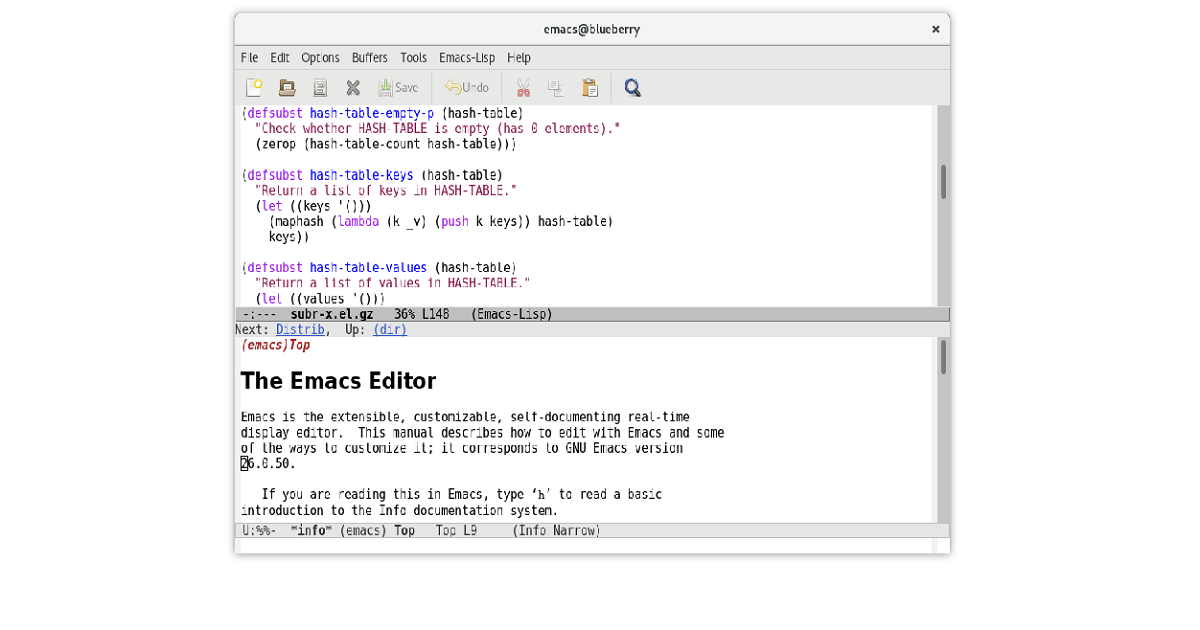
Some days ago the release of the new version of GNU Emacs 28.1 was announced, version in which some pretty cool improvements have been made Of which we can highlight the ability to compile Lisp files, the addition of support for Unicode 14.0 and also improvements to support for emoji, among other things.
For those who are unfamiliar with this popular text editor, they should know that GNU Emacs is an extensible, customizable, free and open text editor created by the founder of the GNU Project, Richard Stallman. This is the most popular of the Emacs family of text editors.
This text editor is available for GNU / Linux, Windows and macOS, It is written in C and provides Emacs Lisp as an extension language. Also implemented in C, Emacs Lisp is a "dialect" of the Lisp programming language used by Emacs as a scripting language.
For those who are not familiar with this text editor, GNU Emacs features include:
- content-sensitive editing modes, including syntax highlighting, for many file types
- Integrated comprehensive documentation, including a tutorial for new users
- Full Unicode support for almost all scripts
- It is also highly customizable, using Emacs Lisp code or a graphical user interface.
- It has a full ecosystem of features beyond text editing, including calendar tracking and a project scheduler (with Org mode), an email and news reader (Gnus), a debugging interface, and more.
- also benefits from a package system (Emacs Lisp Package Archive or ELPA) to download and install extensions
- And many more
Main new features of GNU Emacs 28.1
In this new version of Emacs 28.1 that is presented, it is highlighted that the ability to compile Lisp files into executable code using libgccjit library, instead of using JIT compilation.
It is mentioned that to enable compilation native when compiling, you must specify the '–with-native-compilation ' option, which will compile all Elisp packages shipped with Emacs into executable code. It is important to mention that by enabling the mode this allows to achieve a noticeable increase in performance.
Another change that stands out in this new version is that, by default, cairo graphics library is used for representation (the '–with-cairo' option is enabled) and for text output, the HarfBuzz glyph layout engine, plus it is mentioned that libXft support has been deprecated.
We can also find in this new version of Emacs 28.1 that se has added support for the Unicode 14.0 specification and has Much improved emoji handling.
In addition to this, it is also highlighted that the ability to load seccomp system call filters ('–seccomp=FILE') for process sandbox isolation has been added and that a new documentation and group display system has been proposed. of functions.
On the other hand, we can also find that added 'context-menu-mode' implementation of context menus displayed on right-click and that the capabilities of the project.el project management package have been significantly expanded.
Finally if you want to know more about it about this new version of the editor, you can check the details in the official announcement In the following link.
How to install Gnu Emacs on Ubuntu and derivatives?
If you are interested in being able to install this new version of Gnu Emacs on your distro, They can do it in two ways.
The first one of them is to do it directly from the Software Center from Ubuntu or with the help of Synaptic.
Although, as you know, application updates are not usually available immediately, so we must wait a few days for it to be made available to everyone.
The other way and the recommended in order to have ya a more current version is by downloading and compiling the source code that can be found on the publisher's official website.